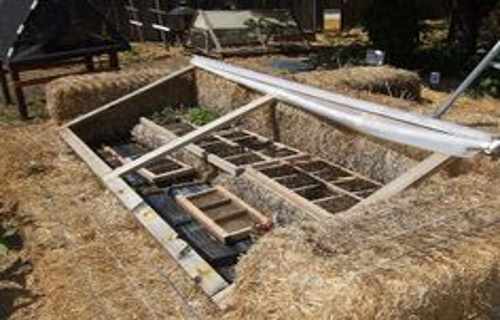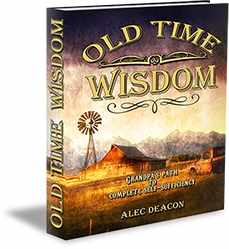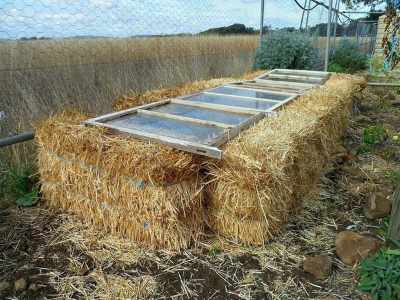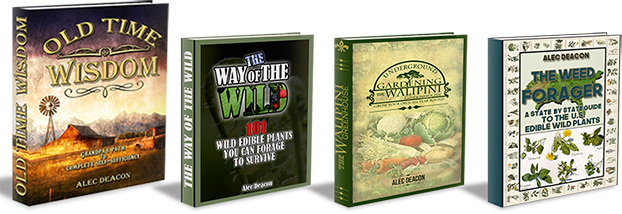Cold frames can be just the answer for those wanting to grow fresh veggies beyond the traditional growing seasons of their area. Often called the poor man’s greenhouse – a well-built diy cold frame can keep fresh greens on the table nearly year around – and at the very least – extend your season by a month on each end!
Cold frames can be used to grow cold-hardy crops like lettuce, kale and spinach. Even as the snow begins to pile up on the ground outside!
In addition, they are a great place for gardeners to start tomato and pepper seedlings in the spring.
A cold frame is nothing more than a simple structure with four walls and a clear roof designed to let in the warming rays of daylight. By nature – they heat up the soil during the day – and keep the plants protected from freezing and frosting temperatures during the cold nights.
The walls can be made from almost anything – wood, brick, stone or even straw or hay bales.
Straw has an astonishing number of farm and garden uses. It makes a cozy bed for animals, a convenient mulch to keep the weeds down and you can even grow a garden on top of unopened bales.
The bales are also good for stacking into play forts, but this time of year, when nights are still cool and the vegetables of summer are calling to be planted, straw bales suffice as building material for a tiny greenhouse, also known as a cold frame.
Like a greenhouse, a cold frame gives you a head start on the growing season so tomatoes, peppers and other vegetables that shiver when the temperature drops below 50 degrees (and keel over when it drops below 32 degrees) have the sauna-like conditions they prefer, even when it’s cold outside.
As a sustainable builder I have always loved working with natural materials and I myself have a fondness for reusing as much as I can whenever I can. So when my friend and long time client asked me about building a cold frame on the south side of her little urban farm I thought it would make sense to work with straw bales.
The concept is simple: the bales are used as an insulated wall and a couple of old window frames make a roof that lets the sun’s rays through, but prevents heat from escaping.
If you want, build your cold frame over an existing garden bed and plant directly into the soil, or build it on any level patch of ground and place flats of potting soil inside for starting summer seedlings.
YOU WILL NEED
Straw bales*
Old windows**
8 pieces of ½-inch by 24-inch rebar
2 8-inch wood stakes
A ‘mini’ sledgehammer
*Straw bales, which are made with just the stalk of the grain, are preferable over hay bales, which include the seedhead of the grain and are intended as animal fodder, not building material.
**The total window area should be roughly 4 to 6 feet by 4 to 6 feet—the exact dimensions aren’t that important because the structure can be adjusted to match. The number of bales needed depends on the size of the windows, as well as the size of the bales.
STEP ONE — ARRANGE THE BALES
Determine which direction is south (hint: it’s at the midpoint between where the sun rises and where it sets) and arrange two bales lengthwise facing that direction. Then place a bale on either end in a perpendicular position to form a three-sided structure. These two bales should be placed so they rest on their skinny side, making them taller than the first two.
STEP TWO — PLACE THE WINDOWS
Lean the windows against the shorter bales at the back of the three-sided structure, allowing the other edge to rest on the ground in front (this creates a slanted surface that is angled toward the sun as it passes through the southern half of the sky). Now, adjust the two side bales to close off the space between the windows and the ground. Drive a wooden stake in the ground at the base of each window so they don’t slip off the straw bales at the other end. Larger windows may require an additional bale on each side to close off the space between the windows and the ground.
STEP THREE — SECURE THE BALES
This is optional, but a good idea if you want the most airtight and secure cold frame. If you are only using the cold frame for a couple of months, you can skip this step. You may need a couple of friends to help with this part. Slide a big handful of loose straw between the two rear bales to fill in the gap where they meet as if you’re chinking the logs of a cabin. Then have two people push the bales toward each other while you pound a rebar stake through each side of the two bales to hold them in place. Add more straw between the side bales and rear bales, if needed.
COLD FRAME TIPS
The windows function as a lid to provide access to the plants inside the cold frame, as well as to provide ventilation so the plants don’t overheat. When the sun is shining, the temperature inside a well-sealed cold frame may be twice the ambient temperature. In sunny weather, prop the windows open a few inches whenever the temperature goes above 40 degrees. If temps are above 50 degrees, remove the windows entirely and return them to the closed position as the sun sets, trapping the heat inside. During early spring, the lid of the cold frame will generally be open during the day and closed only at night.
Timeless Bits of Wisdom on How to Grow Everything Organically, from the Good Old Days When Everyone Did
Old-time gardeners were ahead of their time! Their ideas for wildflower gardens, children’s gardens, organic pest controls, decorating with houseplants, healing with herbs, and more are at the forefront of modern gardening trends. Take a look back to the future of gardening with this incredible collection of gardening advice from successful 17th-, 18th-, 19th-, and early 20th-century gardeners.
Early gardeners knew what they were doing–they had to, since they depended on their plants for food, medicine, home decorations, and recreation! Whether you’re growing vegetables, flowers, herbs, fruits, trees, shrubs, wildflowers, houseplants, or lawn grass, these old-time tips will help you get the most out of your plantings. Do you want a lusher lawn? How about more beautiful flowerbeds or hints for making your yard look bigger? You’ll find all that and more in Old Time Wisdom.
Old-Time Wisdom” boxes present early gardeners’ best planting notions.
* Tried-and-true recipes from early kitchens will tickle your tastebuds.
* “Strange but True” boxes reveal weird, wacky, and wonderful gardening techniques.
* A source list makes it easy to locate wonderful old-time plants.
* Authentic old-time illustrations take you back to a time when garden tips were on everyone’s lips.
* A “Recommended Reading” list guides you to more great ideas from the past.
Books can be your best pre-collapse investment.
The Lost Ways (Learn the long forgotten secrets that helped our forefathers survive famines,wars,economic crisis and anything else life threw at them)
Survival MD (Best Post Collapse First Aid Survival Guide Ever)
Conquering the coming collapse (Financial advice and preparedness )
Liberty Generator (Build and make your own energy source)
Backyard Liberty (Easy and cheap DIY Aquaponic system to grow your organic and living food bank)
Bullet Proof Home (A Prepper’s Guide in Safeguarding a Home )
Family Self Defense (Best Self Defense Strategies For You And Your Family)
Survive Any Crisis (Best Items To Hoard For A Long Term Crisis)
Survive The End Days (Biggest Cover Up Of Our President)





